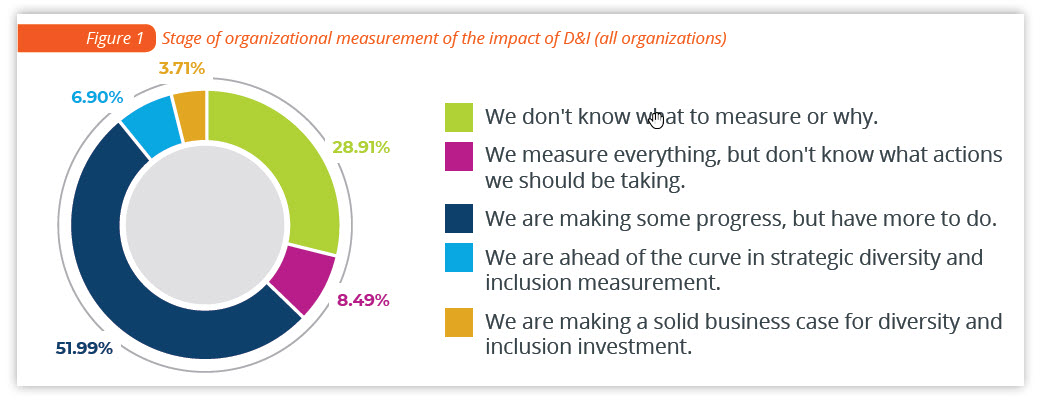As organizations look to D&I initiatives as drivers of organizational success, HR and diversity leaders look for successful programs to emulate. In this blog post, we share insights from our 2019 Strategic Diversity Measurement Survey.
U.S. demographics are changing.
Employment is hitting unprecedented highs. Birth rates are down. And according to the US Census, a significant percentage of workers are due to retire in the next 5-10 years.
These dynamics, coupled with powerful social forces, make workforce diversity necessary to organizational survival—as a means of exponentially enlarging the pool of skilled talent and a key to new markets (among other competitive advantages).
None of this is news to business or HR leaders. D&I has been at the forefront of conversations in HR and boardrooms for years. HR and business leaders have been chasing the elusive “best practice” in an effort to up their game and create a truly inclusive work culture.
Yet while organizations need to take steps to improve, often they have little guidance about how to establish and accomplish their goals—much less measure their efforts.
To help organizations chart a course toward greater success with diversity initiatives, Affirmity partnered with the Human Capital Media Research and Advisory Group to find out what successful organizations do differently.
The State of Strategic Diversity Measurement in 2019
Diversity measurement has come a long way in recent years:
- More than 50% of organizations said they’ve made progress since 2015.
- Nearly 90% of organizations track workforce demographics in some way, either using an integrated system, specialized software, or a manual process.
- More than 50% track metrics through an integrated HR system.
Respondents acknowledged that their organizations still have work to do to better track and understand the impact of their D&I programs.
 One reason organizations feel this way could be that diversity and inclusion work is never truly finished. D&I initiatives are, by nature, ongoing, and don’t stop at worker parity.
One reason organizations feel this way could be that diversity and inclusion work is never truly finished. D&I initiatives are, by nature, ongoing, and don’t stop at worker parity.
How Mature Organizations Use Diversity Metrics
The definition of D&I organizational maturity hinges on the relationship between workforce analytics (diversity measurement) and organizational goals (strategic diversity).
Tracking metrics is only one step in implementing D&I initiatives; organizations must use those metrics in some functional way. Organizations further along in the D&I maturity model put forth in our diversity measurement survey have figured out how to use these metrics to:
- Align D&I strategy on organizational goals and needs
- Inform strategic planning for D&I efforts
- Set annual goals for improving D&I across the organization
- Use analytics to address bias and disparities in recruiting and succession planning.
Within the most mature organizations, HR and leadership can see the direct contributions of D&I initiatives to organizational goals such as innovation, recruitment, retention, and succession planning.
Related read: What Does Diversity Really Mean?
3 Best Practices for Strategic D&I Measurement
In addition to the way they apply diversity metrics to inform their D&I programs, organizations with mature diversity measurement share other important commonalities. These differentiators transform diversity metrics and workforce data into diversity insights, adding context and meaning to the data and putting that data to work for the organization.
Organizations looking to elevate their diversity programs to a strategic level can focus on the following:
1. Secure and Sustain Leadership Support for D&I through Reporting on Diversity Metrics
Advanced organizations have more leadership buy-in, which helps them break through potential roadblocks and secure budgets for program implementation. They secure this support through clear and consistent reporting to leadership on diversity metrics.
Advanced organizations are 20-25% more likely to report workforce diversity metrics to the CEO, senior executives, and board of directors. They’re also much more likely than the average to report diversity metrics to non-HR mid-level managers.
2. Use External Data Sources to Benchmark Diversity Data
Collecting information on the current workforce is a basic tenet of strategic diversity measurement. But benchmarking is what makes the data meaningful. Advanced organizations are on board with external benchmarking. They use industry, census, or other outside data to inform their diversity goals and measure success at increasing representation compared to its industry or community at large.
3. Invest in Workforce Analytics Capabilities
Measurement starts with the ability to track workforce demographics in some way. Advanced organizations use specialized tools to track demographics, but the technology is less important than the actual act of measurement.
Organizations also need the expertise to analyze and understand workforce diversity data and communicate that data with stakeholders. Survey respondents identified the lack of measurement expertise as the No. 1 roadblock faced by their diversity programs.
Whether internal or external, access to experts in workforce analytics is critical to successful diversity initiatives.
Transforming Diversity Data into Diversity Insights
Advancing D&I measurement starts with the obvious: Collecting a robust set of workforce diversity metrics. From there, smart organizations transform that data into insights through benchmarking and analysis, and then put the data to work by communicating with executives.
As a result, these advanced organizations report fewer roadblocks to implementing their diversity strategies and better outcomes.
In this way, a strategic approach to diversity measurement creates a virtuous cycle of demonstrated value and contribution to organizational goals and success.
